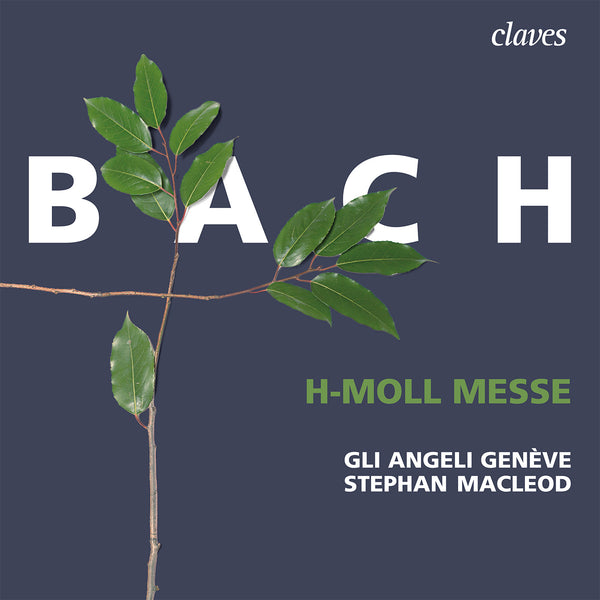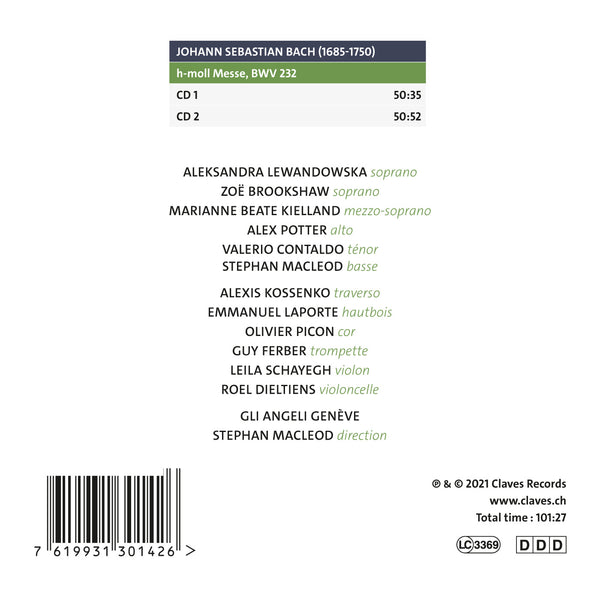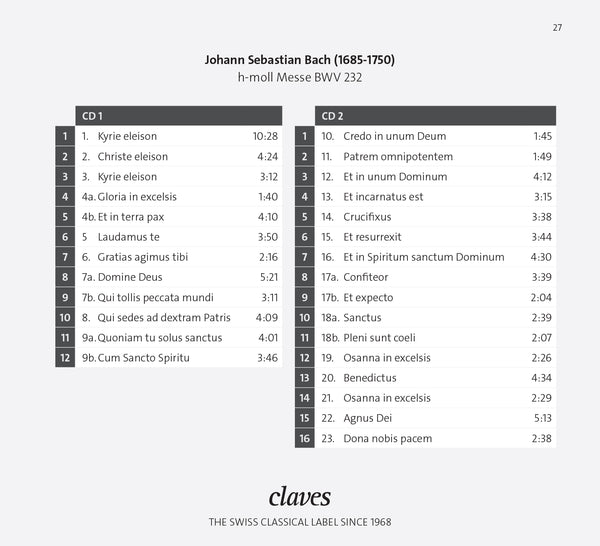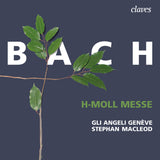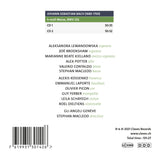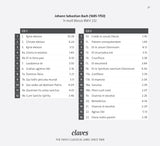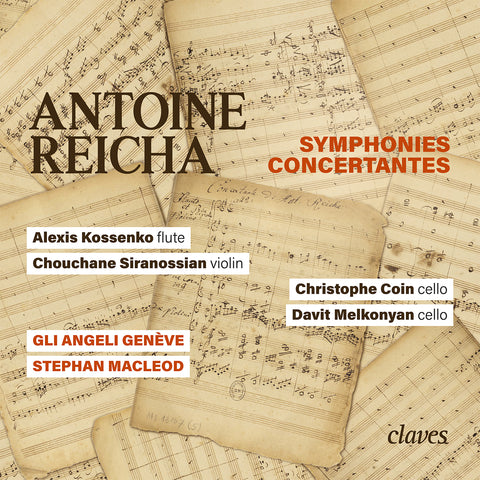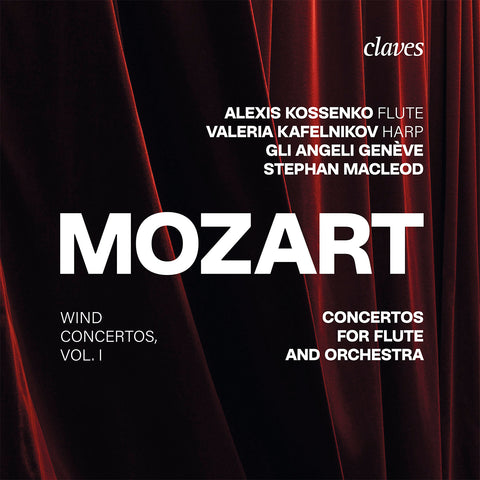(2021) Bach: h-moll Messe, Gli Angeli Genève, Stephan Macleod
Category(ies): Ancient music Oper vocal Repertoire
Instrument(s): Cello Flute Horn Oboe Trumpet Violin
Vocal(s): Alto Mezzo-soprano Soprano Tenor
Main Composer: Johann Sebastian Bach
Ensemble: Gli Angeli Genève
Conductor: Stephan MacLeod
CD set: 2
Catalog N°:
CD 3014/15
Release: 26.03.2021
EAN/UPC: 7619931301426
This album is now on repressing. Pre-order it at a special price now.
CHF 24.00
This album has not been released yet. Pre-order it from now.
CHF 24.00
CHF 24.00
VAT included for Switzerland & UE
Free shipping
VAT included for Switzerland & UE
Free shipping
This album is now on repressing. Pre-order it at a special price now.
CHF 24.00
This album has not been released yet.
Pre-order it at a special price now.
CHF 24.00
CHF 24.00
BACH: H-MOLL MESSE, GLI ANGELI GENÈVE, STEPHAN MACLEOD
Bach - The Mass in B minor
The Mass in B minor holds a very special place in J.S. Bach’s output: a work of grandeur, an opus ultimum, it was not composed as such but is the result of an assembly of pieces written at different times and for different circumstances. Bach worked on it during the years 1748-1749, until his eyesight, which had gradually deteriorated, was completely lost - a letter of recommendation for his son Johann Christoph Friedrich, dated 17 December 1749, was written by Anna Magdalena, who imitated his signature. It was rumoured in Leipzig that the cantor’s health had deteriorated to such an extent that the city council, on the orders of the all-powerful minister of Saxony, auditioned a conductor from Dresden on 8 June 1749, who had been recommended to him for “the future post of cantor of St. Thomas if the director musices Sebastian Bach should pass away”. By this time Bach was working on his Mass, which was larger than anything that had ever been conceived before[1]. His rather pale successor had to wait another year to replace him, Bach having died on 28 July 1750.
***
A monumental mass
The idea of bringing together pieces drawn essentially from the vast corpus of cantatas was not unusual; a similar approach was taken by several of his contemporaries, such as Handel, and Bach himself had done so for the short masses he composed in the late 1730s[2]. These were called parodies. Moving from the German text of the cantatas to the Latin text of the masses meant adapting the vocal lines, with additions and deletions, polyphonic and harmonic enrichments, and changes in instrumentation. Throughout his life, Bach never ceased to revisit his works with a view to improving them.
Imagining the production of a monumental Mass, which can be seen as a musical testament to him, Bach began by exploring the repertoire of his own music, while studying various Masses by other composers that were available to him (and among the scores he studied was Pergolesi’s Stabat mater, which he himself had adapted). He decided above all to use a mass (Missa in Lutheran language) composed in 1733 after the death on February 1 of Augustus the Strong, ruler of Lutheran Saxony, on which Leipzig and Catholic Poland depended. It consisted, as was the case with the Lutheran masses, of the Kyrie and the Gloria, the music of which was largely original (only four of the nine pieces in the Gloria come from earlier compositions). But Bach wanted to compose a Mass with the different parts of the Catholic Ordinary, with the Credo, Sanctus, Benedictus and Agnus Dei. Faced with the magnitude of the two movements of the Missa, each as impressive as the other, Bach was compelled to write a large Credo.
The 1733 Kyrie was conceived as a tribute to the deceased, with the Gloria celebrating his successor, who was none other than his own son (they were both great advocates of the arts). It is not known whether the work was performed in Leipzig, or whether it was created in the capital of Saxony. Apparently not, no document mentions it. In any case, the score was sent to the new ruler at the end of July, with the separate parts that several members of the Bach family had hastily copied; it was accompanied by a request in which the cantor complained of the “affronts” suffered in Leipzig, hoping to strengthen his position by obtaining a position as court composer, a purely honorary position that carried no obligation. A month earlier he had had his eldest son, Wilhelm Friedemann, appointed as organist of St. Sophia Cathedral in Dresden. However, Frederick Augustus II was then caught up in the war of succession for the Polish throne, which was being contested. Bach’s request, reiterated three years later, came to fruition as he was battling with the new rector of St. Thomas and the Leipzig Council, whom the sovereign ultimately ordered that Bach be allowed to exercise his musical authority.
>> Read more in the booklet <<
__________
[1] The Mass in B minor lasts about one hour and forty minutes, making it a very unusual work, which could not be integrated into a religious ceremony. Zelenka’s Missa votiva, which dates from 1739 and has a structure quite similar to Bach’s, lasts a little over an hour (Zelenka, whose music Bach knew, was a composer at the court of Dresden).
[2] In addition to the Missa of 1733 discussed here, Bach composed four Lutheran masses (consisting only of a Kyrie and a Gloria): BWV 233 to 236.
***
Ten singers for a Mass in B minor
For years now, musicology and musicians have been addressing the question of the vocal forces that Johann Sebastian Bach had at his disposal for his cantatas and passions. With the help of occasionally newly discovered sources and in-depth studies, we have been able to find enlightening answers to a problem that is essential for the interpretation of his music. In this context, it seems important to me to make it clear that we did not approach the Mass in B minor if with an ensemble of ten singers for the sake of authenticity, nor to assert our point of view on how things should or should not be done. We sometimes forget in the quest for authenticity that musicians, then as now, have always been pragmatic and have always been willing to adapt to different constraints: budgets, tuning forks, numbers, available instruments, etc. Historical reality alone is therefore not systematically a notion as relevant as all that, and we have no ambition to take part in the often-fascinating debates that such research gives rise to. If our work can contribute to the development of certain points of view, give relevance to others, cause people to react, and help the progress of certain ideas and convictions, so much the better, but our own motivations are different.
From its creation in 2005, Gli Angeli Genève has approached Bach’s music with two singers per part: i. e. eight singers for most of the cantatas, eight singers for the St John Passion, sixteen for the St Matthew Passion and its two choirs (as our recording published by Claves in April 2020 shows), ten for the Magnificat (where the choirs have five parts) or for the Mass in B minor (where a complement of twelve singers would be more logical because of the six-part Sanctus). Two singers per part in the choirs is the number of singers in Carl Philip Emmanuel Bach’s choir for many of his great oratorios, and the number of singers in Joseph Haydn’s choir for many of his masses. But here again, these historical realities are not the basis of our approach and choice. A musician may be justified in his need to legitimize his aesthetic choices by his knowledge of history, but if the search for authenticity becomes the sole driving force behind his work, he may go astray. It is therefore another factor that attracts and motivates us.
In Bach’s time, singers in Leipzig, regardless of their precise numbers, sang in front of the instrumentalists and not behind them. Religious music existed according to the verb it magnified, since instrumentalists and singers shared the same language and culture at the time. By placing the singers in front of the instruments today, as we do with Gli Angeli Genève, we are restoring the word to its rightful place: the first, the one that founds and inspires this vocal music. And if the choir sings in front of the instruments, it doesn’t need to have many members, as the balance between voice and orchestra is much easier to achieve. That is the difference between the classical position of a large choir behind the instruments, the layout with which my generation grew up, listened, played, sung and learned this music, and which is still the most common today in churches and concert halls.
Finally, two voices singing the same part cannot merge into a single sound or a single colour of register, as is already possible with three. This is a far cry from the fullness of sound of the great Romantic choir. On the other hand, the voices of such an ensemble are more individualised, both in sound and interpretation. In the case of Gli Angeli Genève, they are the voices of a group of friends who have decided to sing together, and to let their respective timbres express their happiness and pleasure in letting music speak for itself.
***
Gli Angeli Geneva - www.gliangeligeneve.com
Gli Angeli Geneva was founded in 2005 by Stephan MacLeod. A formation of varying size, playing on period instruments (or copies thereof), the ensemble is made up of musicians who have careers in the field of baroque music, but who are not only active in this field: they do not play solely early music. Their eclecticism guarantees the vitality of their enthusiasm. It is also a driving force behind their curiosity.
Right from the beginning of a musical adventure that for several years concentrated solely on live performances of the complete Bach Cantatas in Geneva, with three concerts per season, Gli Angeli Genève has been the setting for encounters between some of the most famous singers and instrumentalists of the international baroque scene and young graduates of the High Schools of Music of Basel, Lyon, Lausanne and Geneva.
Internationally acclaimed since the release in 2009 and 2010 of its first two CDs, which won numerous critical awards, the ensemble now gives seven or eight concerts per season in Geneva, as part of its Complete Bach Cantatas on the one hand, a series of annual concerts at the Victoria Hall on the other, and since September 2017 in a new complete series dedicated to Haydn’s Symphonies. The ensemble is equally in demand in Switzerland and abroad for performances not only of Bach, but also Tallis, Josquin, Schein, Schütz, Johann Christoph Bach, Weckmann, Buxtehude, Rosenmüller, Haydn, Mozart and others. In recent seasons, Gli Angeli Genève has been in residence at the Utrecht Festival and the Thüringer Bachwochen, and has also performed in Basel, Zurich, Lucerne, Barcelona, Nürnberg, Bremen, Stuttgart, Brussels, Milan, Wroclaw, Paris, Ottawa, Vancouver, Amsterdam and The Hague. Gli Angeli Genève is a regular guest at the Festival de Saintes, Utrecht festival, the Musikfest in Bremen or the Bach Festival in Vancouver. The ensemble made its debut in 2017 at the Grand Théâtre in Geneva and in 2019 at the KKL in Lucerne.
Gli Angeli Genève’s penultimate recording for Claves, Sacred Music of the 17th Century in Wroclaw, won the 2019 ICMA prize for best vocal baroque music recording of the year, and his latest, The St Matthew Passion by Johann Sebastian Bach, is receiving an enthusiastic reception, both from the public and critics, in Switzerland and around the world.
All texts translated from French by Isabelle Watson
REVIEWS
“This studio recording of Bach’s greatest work, though one he only ever heard in his imagination, is notable for its transparent textures due to MacLeod’s decision to limit his singers to ten – a decision taken when Gli Angeli Genève was founded in 2005. In his booklet note MacLeod persuasively argues that such restrictions are not undertaken for strict historical authenticity – other reasons pertain, including placing all the singers in front of the instrumentalists, as would have occurred in the Thomaskirche in Bach’s day. On the recording this has the benefit of foregrounding the text and thereby to an extent solving many of the balance issues that occur in a conventional set-up. [..]” -Philip Reed, August 2021
« [..] Ansonsten punktet sie mit ihrer technischen Perfektion und ihrer musikalischen Homogenität. MacLeod geht es mehr um analytische Klarheit als um spirituelle Überhöhung; dementsprechend direkt und zügig ist sein Ansatz. Von den durchweg exzellenten Instrumentalsoli ist Leila Schayeghs Geigenspiel im „Laudamus te“ besonders hervorzuheben. » - Matthias Hengelbrock, September 2021
« [..] Dans cet opus, Stephan MacLeod et son ensemble Gli Angeli Genève abordent la messe avec dix chanteurs au total. Bach faisait pareil pour ses cantates de sorte à favoriser la parole à l'orchestre. Les voix s'épanouissent et sont soutenues admirablement par l'orchestre. [..] » - Septembre 2021
“Gli Angeli Genève perform the Mass in B minor with 10 singers (six concertists and four ripienists) and an orchestra of 27 players, each section led by outstanding musicians. Director (and bass) Stephan MacLeod enthuses that two singers on each line in the choruses, placed in front of the orchestra instead of behind it, is ‘more individualised, both in sound and interpretation … their respective timbres express their happiness and pleasure in letting music speak for itself’. [..] Overall, Gli Angeli Genève’s performance is characterised by swift momentum, crisp articulation and benevolent attention to detail.” - David Vickers, July 2021
« [..] Nach der famosen Matthäus-Passion vor einem Jahr nun eine h-Moll-Messe vom selben Kaliber: Ein Plädoyer für die schlanke Vokalbesetzung, ohne ideologische Verengung oder argumentativen Schaum vor dem Mund. Im Gegenteil: Ein funkensprühendes Erlebnis hochstehender Musikalität und stupenden Vermögens. Stephan MacLeod und sein Ensemble Gli Angeli Genève treten seit längerer Zeit vernehmlich als – vielleicht weithin nicht genug geschätzte – Bach-Kraft von Rang hervor. Dazu ist es ein wunderbares künstlerisches Lebenszeichen aus dem düsteren Corona-Herbst 2020. » - Dr. Matthias Lange, Mai 2021
« Interview. Il y a un an, Stephan MacLeod émouvait déjà dans Bach. La Passion selon saint Matthieu de l’ensemble Gli Angeli Genève faisait exploser les compteurs des téléchargements de la maison Claves. Une période de confinement en chasse une autre: il faut aujourd’hui encore se contenter de captations ou d’enregistrements en ce temps de Pâques. Mais Bach est toujours là qui nous tient la main, nous console et nous rassure de la beauté du monde. Interview du chef, qui offre ce printemps la Messe en si mineur. [..] » - Elisabeth Hass, avril 2021
“[..] Emotions are relegated to the background, instead much emphasis is placed on an objective and therefore very academic interpretation, which at best can please those who like an intellectual and professorial Bach.” - Alain Steffen, mars 2021
“[..] This is a creation of a very high level of interpretation, carefully thought out and carefully realised in the context of historical performance practices and the use of appropriate instrumentation, as evidenced by the very person of the ensemble's conductor and bass player, Stephen MacLeod, an artist who researches the lesser-known Baroque repertoire. [..] If I had to characterise this recording in a few words or one sentence, I would use the following words: beautiful, honest and modest. There are many fine recordings of this repertoire, more or less famous, spectacular and exciting, but by communing with the creation of the singers and the ensemble of Gli Angeli Genève under the direction of Stephan MacLeod, I was able not only to relax but also to comfort my mind, my heart and my soul. [..]” - Paweł Chmielowski, August 2021
“[..] The smaller forces in this new recording give a lovely transparency to the overall sound, beneficial in such compositional complexity, and an intimacy missing in recordings using greater numbers. The string players use period instruments, adding to the clarity of texture. Ensemble work throughout is exceptional. The booklet lists the choir and orchestra on the front and photos of the performers are included. The comprehensive introduction is in three languages, but the Latin text is only translated into French. [..]” - Patrice Connolly, April 2022
« [..] Aber gerade deswegen ruft es Begeisterung hervor, wenn es einem erfahrenen Interpreten wie Stephan MacLeod gelingt, mit höchst sorgfältig ausgewählten Musikerinnen und Musikern ein Ensemble zu formieren, das den „Beinahe-Normalfall“ einer entsprechend routinierten Darbietung nochmals deutlich überbietet. MacLeod selbst leuchtet voran in der fordernden Doppelaufgabe des Vokalisten und Ensembleleiters. Zur vokalen Leistung gehört nicht zuletzt auch die brillante Bewältigung der beiden in der Tessitura so verschiedenen Bassarien. Zu ihm gesellen sich hervorragende Sängerinnen und Sänger, die gerade auch in der heiklen Zwei-pro-Stimme-Besetzung der Chorsätze eine erstaunliche Homogenität zu erzeugen verstehen. Gemeinsam mit den gleichermaßen brillanten Instrumentalistinnen und Instrumentalisten bringen sie es zu einer geschmeidigen Eleganz und filigranen Transparenz des Klanges, die ihresgleichen sucht. [..] » - Michael Wersin, Mai 2021
« Avec la Messe en si, la formation poursuit avec pertinence son exploration de Bach en s’attaquant à un monument. [..] » - Rocco Zacheo, avril 2021
« [..] Es gibt unendlich viele Aufnahmen der h-Moll-Messe. Eine neue lässt jetzt aufhorchen: Das Ensemble Gli Angeli Genève unter Leitung des mitsingenden Bassisten Stephan McLeod hat eine wirklich überzeugende und berückende Einspielung von Bachs Opus ultimum vorgelegt. [..] Diese CD sei allen, die Bach lieben, dringlichst empfohlen, egal wie viele Aufnahmen des exzeptionellen Werkes bereits im Regal stehen – und Erstlingen in Sachen h-Moll-Messe sowieso. Und da es ein Werk für alle (Kirchenjahres-)Zeiten ist, eignet es sich auch trefflich dafür, unter dem Christbaum zu liegen. » - Reinhard Mawick, November 2022
(2021) Bach: h-moll Messe, Gli Angeli Genève, Stephan Macleod - CD 3014/15
Bach - The Mass in B minor
The Mass in B minor holds a very special place in J.S. Bach’s output: a work of grandeur, an opus ultimum, it was not composed as such but is the result of an assembly of pieces written at different times and for different circumstances. Bach worked on it during the years 1748-1749, until his eyesight, which had gradually deteriorated, was completely lost - a letter of recommendation for his son Johann Christoph Friedrich, dated 17 December 1749, was written by Anna Magdalena, who imitated his signature. It was rumoured in Leipzig that the cantor’s health had deteriorated to such an extent that the city council, on the orders of the all-powerful minister of Saxony, auditioned a conductor from Dresden on 8 June 1749, who had been recommended to him for “the future post of cantor of St. Thomas if the director musices Sebastian Bach should pass away”. By this time Bach was working on his Mass, which was larger than anything that had ever been conceived before[1]. His rather pale successor had to wait another year to replace him, Bach having died on 28 July 1750.
***
A monumental mass
The idea of bringing together pieces drawn essentially from the vast corpus of cantatas was not unusual; a similar approach was taken by several of his contemporaries, such as Handel, and Bach himself had done so for the short masses he composed in the late 1730s[2]. These were called parodies. Moving from the German text of the cantatas to the Latin text of the masses meant adapting the vocal lines, with additions and deletions, polyphonic and harmonic enrichments, and changes in instrumentation. Throughout his life, Bach never ceased to revisit his works with a view to improving them.
Imagining the production of a monumental Mass, which can be seen as a musical testament to him, Bach began by exploring the repertoire of his own music, while studying various Masses by other composers that were available to him (and among the scores he studied was Pergolesi’s Stabat mater, which he himself had adapted). He decided above all to use a mass (Missa in Lutheran language) composed in 1733 after the death on February 1 of Augustus the Strong, ruler of Lutheran Saxony, on which Leipzig and Catholic Poland depended. It consisted, as was the case with the Lutheran masses, of the Kyrie and the Gloria, the music of which was largely original (only four of the nine pieces in the Gloria come from earlier compositions). But Bach wanted to compose a Mass with the different parts of the Catholic Ordinary, with the Credo, Sanctus, Benedictus and Agnus Dei. Faced with the magnitude of the two movements of the Missa, each as impressive as the other, Bach was compelled to write a large Credo.
The 1733 Kyrie was conceived as a tribute to the deceased, with the Gloria celebrating his successor, who was none other than his own son (they were both great advocates of the arts). It is not known whether the work was performed in Leipzig, or whether it was created in the capital of Saxony. Apparently not, no document mentions it. In any case, the score was sent to the new ruler at the end of July, with the separate parts that several members of the Bach family had hastily copied; it was accompanied by a request in which the cantor complained of the “affronts” suffered in Leipzig, hoping to strengthen his position by obtaining a position as court composer, a purely honorary position that carried no obligation. A month earlier he had had his eldest son, Wilhelm Friedemann, appointed as organist of St. Sophia Cathedral in Dresden. However, Frederick Augustus II was then caught up in the war of succession for the Polish throne, which was being contested. Bach’s request, reiterated three years later, came to fruition as he was battling with the new rector of St. Thomas and the Leipzig Council, whom the sovereign ultimately ordered that Bach be allowed to exercise his musical authority.
>> Read more in the booklet <<
__________
[1] The Mass in B minor lasts about one hour and forty minutes, making it a very unusual work, which could not be integrated into a religious ceremony. Zelenka’s Missa votiva, which dates from 1739 and has a structure quite similar to Bach’s, lasts a little over an hour (Zelenka, whose music Bach knew, was a composer at the court of Dresden).
[2] In addition to the Missa of 1733 discussed here, Bach composed four Lutheran masses (consisting only of a Kyrie and a Gloria): BWV 233 to 236.
***
Ten singers for a Mass in B minor
For years now, musicology and musicians have been addressing the question of the vocal forces that Johann Sebastian Bach had at his disposal for his cantatas and passions. With the help of occasionally newly discovered sources and in-depth studies, we have been able to find enlightening answers to a problem that is essential for the interpretation of his music. In this context, it seems important to me to make it clear that we did not approach the Mass in B minor if with an ensemble of ten singers for the sake of authenticity, nor to assert our point of view on how things should or should not be done. We sometimes forget in the quest for authenticity that musicians, then as now, have always been pragmatic and have always been willing to adapt to different constraints: budgets, tuning forks, numbers, available instruments, etc. Historical reality alone is therefore not systematically a notion as relevant as all that, and we have no ambition to take part in the often-fascinating debates that such research gives rise to. If our work can contribute to the development of certain points of view, give relevance to others, cause people to react, and help the progress of certain ideas and convictions, so much the better, but our own motivations are different.
From its creation in 2005, Gli Angeli Genève has approached Bach’s music with two singers per part: i. e. eight singers for most of the cantatas, eight singers for the St John Passion, sixteen for the St Matthew Passion and its two choirs (as our recording published by Claves in April 2020 shows), ten for the Magnificat (where the choirs have five parts) or for the Mass in B minor (where a complement of twelve singers would be more logical because of the six-part Sanctus). Two singers per part in the choirs is the number of singers in Carl Philip Emmanuel Bach’s choir for many of his great oratorios, and the number of singers in Joseph Haydn’s choir for many of his masses. But here again, these historical realities are not the basis of our approach and choice. A musician may be justified in his need to legitimize his aesthetic choices by his knowledge of history, but if the search for authenticity becomes the sole driving force behind his work, he may go astray. It is therefore another factor that attracts and motivates us.
In Bach’s time, singers in Leipzig, regardless of their precise numbers, sang in front of the instrumentalists and not behind them. Religious music existed according to the verb it magnified, since instrumentalists and singers shared the same language and culture at the time. By placing the singers in front of the instruments today, as we do with Gli Angeli Genève, we are restoring the word to its rightful place: the first, the one that founds and inspires this vocal music. And if the choir sings in front of the instruments, it doesn’t need to have many members, as the balance between voice and orchestra is much easier to achieve. That is the difference between the classical position of a large choir behind the instruments, the layout with which my generation grew up, listened, played, sung and learned this music, and which is still the most common today in churches and concert halls.
Finally, two voices singing the same part cannot merge into a single sound or a single colour of register, as is already possible with three. This is a far cry from the fullness of sound of the great Romantic choir. On the other hand, the voices of such an ensemble are more individualised, both in sound and interpretation. In the case of Gli Angeli Genève, they are the voices of a group of friends who have decided to sing together, and to let their respective timbres express their happiness and pleasure in letting music speak for itself.
***
Gli Angeli Geneva - www.gliangeligeneve.com
Gli Angeli Geneva was founded in 2005 by Stephan MacLeod. A formation of varying size, playing on period instruments (or copies thereof), the ensemble is made up of musicians who have careers in the field of baroque music, but who are not only active in this field: they do not play solely early music. Their eclecticism guarantees the vitality of their enthusiasm. It is also a driving force behind their curiosity.
Right from the beginning of a musical adventure that for several years concentrated solely on live performances of the complete Bach Cantatas in Geneva, with three concerts per season, Gli Angeli Genève has been the setting for encounters between some of the most famous singers and instrumentalists of the international baroque scene and young graduates of the High Schools of Music of Basel, Lyon, Lausanne and Geneva.
Internationally acclaimed since the release in 2009 and 2010 of its first two CDs, which won numerous critical awards, the ensemble now gives seven or eight concerts per season in Geneva, as part of its Complete Bach Cantatas on the one hand, a series of annual concerts at the Victoria Hall on the other, and since September 2017 in a new complete series dedicated to Haydn’s Symphonies. The ensemble is equally in demand in Switzerland and abroad for performances not only of Bach, but also Tallis, Josquin, Schein, Schütz, Johann Christoph Bach, Weckmann, Buxtehude, Rosenmüller, Haydn, Mozart and others. In recent seasons, Gli Angeli Genève has been in residence at the Utrecht Festival and the Thüringer Bachwochen, and has also performed in Basel, Zurich, Lucerne, Barcelona, Nürnberg, Bremen, Stuttgart, Brussels, Milan, Wroclaw, Paris, Ottawa, Vancouver, Amsterdam and The Hague. Gli Angeli Genève is a regular guest at the Festival de Saintes, Utrecht festival, the Musikfest in Bremen or the Bach Festival in Vancouver. The ensemble made its debut in 2017 at the Grand Théâtre in Geneva and in 2019 at the KKL in Lucerne.
Gli Angeli Genève’s penultimate recording for Claves, Sacred Music of the 17th Century in Wroclaw, won the 2019 ICMA prize for best vocal baroque music recording of the year, and his latest, The St Matthew Passion by Johann Sebastian Bach, is receiving an enthusiastic reception, both from the public and critics, in Switzerland and around the world.
All texts translated from French by Isabelle Watson
REVIEWS
“This studio recording of Bach’s greatest work, though one he only ever heard in his imagination, is notable for its transparent textures due to MacLeod’s decision to limit his singers to ten – a decision taken when Gli Angeli Genève was founded in 2005. In his booklet note MacLeod persuasively argues that such restrictions are not undertaken for strict historical authenticity – other reasons pertain, including placing all the singers in front of the instrumentalists, as would have occurred in the Thomaskirche in Bach’s day. On the recording this has the benefit of foregrounding the text and thereby to an extent solving many of the balance issues that occur in a conventional set-up. [..]” -Philip Reed, August 2021
« [..] Ansonsten punktet sie mit ihrer technischen Perfektion und ihrer musikalischen Homogenität. MacLeod geht es mehr um analytische Klarheit als um spirituelle Überhöhung; dementsprechend direkt und zügig ist sein Ansatz. Von den durchweg exzellenten Instrumentalsoli ist Leila Schayeghs Geigenspiel im „Laudamus te“ besonders hervorzuheben. » - Matthias Hengelbrock, September 2021
« [..] Dans cet opus, Stephan MacLeod et son ensemble Gli Angeli Genève abordent la messe avec dix chanteurs au total. Bach faisait pareil pour ses cantates de sorte à favoriser la parole à l'orchestre. Les voix s'épanouissent et sont soutenues admirablement par l'orchestre. [..] » - Septembre 2021
“Gli Angeli Genève perform the Mass in B minor with 10 singers (six concertists and four ripienists) and an orchestra of 27 players, each section led by outstanding musicians. Director (and bass) Stephan MacLeod enthuses that two singers on each line in the choruses, placed in front of the orchestra instead of behind it, is ‘more individualised, both in sound and interpretation … their respective timbres express their happiness and pleasure in letting music speak for itself’. [..] Overall, Gli Angeli Genève’s performance is characterised by swift momentum, crisp articulation and benevolent attention to detail.” - David Vickers, July 2021
« [..] Nach der famosen Matthäus-Passion vor einem Jahr nun eine h-Moll-Messe vom selben Kaliber: Ein Plädoyer für die schlanke Vokalbesetzung, ohne ideologische Verengung oder argumentativen Schaum vor dem Mund. Im Gegenteil: Ein funkensprühendes Erlebnis hochstehender Musikalität und stupenden Vermögens. Stephan MacLeod und sein Ensemble Gli Angeli Genève treten seit längerer Zeit vernehmlich als – vielleicht weithin nicht genug geschätzte – Bach-Kraft von Rang hervor. Dazu ist es ein wunderbares künstlerisches Lebenszeichen aus dem düsteren Corona-Herbst 2020. » - Dr. Matthias Lange, Mai 2021
« Interview. Il y a un an, Stephan MacLeod émouvait déjà dans Bach. La Passion selon saint Matthieu de l’ensemble Gli Angeli Genève faisait exploser les compteurs des téléchargements de la maison Claves. Une période de confinement en chasse une autre: il faut aujourd’hui encore se contenter de captations ou d’enregistrements en ce temps de Pâques. Mais Bach est toujours là qui nous tient la main, nous console et nous rassure de la beauté du monde. Interview du chef, qui offre ce printemps la Messe en si mineur. [..] » - Elisabeth Hass, avril 2021
“[..] Emotions are relegated to the background, instead much emphasis is placed on an objective and therefore very academic interpretation, which at best can please those who like an intellectual and professorial Bach.” - Alain Steffen, mars 2021
“[..] This is a creation of a very high level of interpretation, carefully thought out and carefully realised in the context of historical performance practices and the use of appropriate instrumentation, as evidenced by the very person of the ensemble's conductor and bass player, Stephen MacLeod, an artist who researches the lesser-known Baroque repertoire. [..] If I had to characterise this recording in a few words or one sentence, I would use the following words: beautiful, honest and modest. There are many fine recordings of this repertoire, more or less famous, spectacular and exciting, but by communing with the creation of the singers and the ensemble of Gli Angeli Genève under the direction of Stephan MacLeod, I was able not only to relax but also to comfort my mind, my heart and my soul. [..]” - Paweł Chmielowski, August 2021
“[..] The smaller forces in this new recording give a lovely transparency to the overall sound, beneficial in such compositional complexity, and an intimacy missing in recordings using greater numbers. The string players use period instruments, adding to the clarity of texture. Ensemble work throughout is exceptional. The booklet lists the choir and orchestra on the front and photos of the performers are included. The comprehensive introduction is in three languages, but the Latin text is only translated into French. [..]” - Patrice Connolly, April 2022
« [..] Aber gerade deswegen ruft es Begeisterung hervor, wenn es einem erfahrenen Interpreten wie Stephan MacLeod gelingt, mit höchst sorgfältig ausgewählten Musikerinnen und Musikern ein Ensemble zu formieren, das den „Beinahe-Normalfall“ einer entsprechend routinierten Darbietung nochmals deutlich überbietet. MacLeod selbst leuchtet voran in der fordernden Doppelaufgabe des Vokalisten und Ensembleleiters. Zur vokalen Leistung gehört nicht zuletzt auch die brillante Bewältigung der beiden in der Tessitura so verschiedenen Bassarien. Zu ihm gesellen sich hervorragende Sängerinnen und Sänger, die gerade auch in der heiklen Zwei-pro-Stimme-Besetzung der Chorsätze eine erstaunliche Homogenität zu erzeugen verstehen. Gemeinsam mit den gleichermaßen brillanten Instrumentalistinnen und Instrumentalisten bringen sie es zu einer geschmeidigen Eleganz und filigranen Transparenz des Klanges, die ihresgleichen sucht. [..] » - Michael Wersin, Mai 2021
« Avec la Messe en si, la formation poursuit avec pertinence son exploration de Bach en s’attaquant à un monument. [..] » - Rocco Zacheo, avril 2021
« [..] Es gibt unendlich viele Aufnahmen der h-Moll-Messe. Eine neue lässt jetzt aufhorchen: Das Ensemble Gli Angeli Genève unter Leitung des mitsingenden Bassisten Stephan McLeod hat eine wirklich überzeugende und berückende Einspielung von Bachs Opus ultimum vorgelegt. [..] Diese CD sei allen, die Bach lieben, dringlichst empfohlen, egal wie viele Aufnahmen des exzeptionellen Werkes bereits im Regal stehen – und Erstlingen in Sachen h-Moll-Messe sowieso. Und da es ein Werk für alle (Kirchenjahres-)Zeiten ist, eignet es sich auch trefflich dafür, unter dem Christbaum zu liegen. » - Reinhard Mawick, November 2022
Return to the album | Read the booklet | Composer(s): Johann Sebastian Bach | Main Artist: Stephan MacLeod






